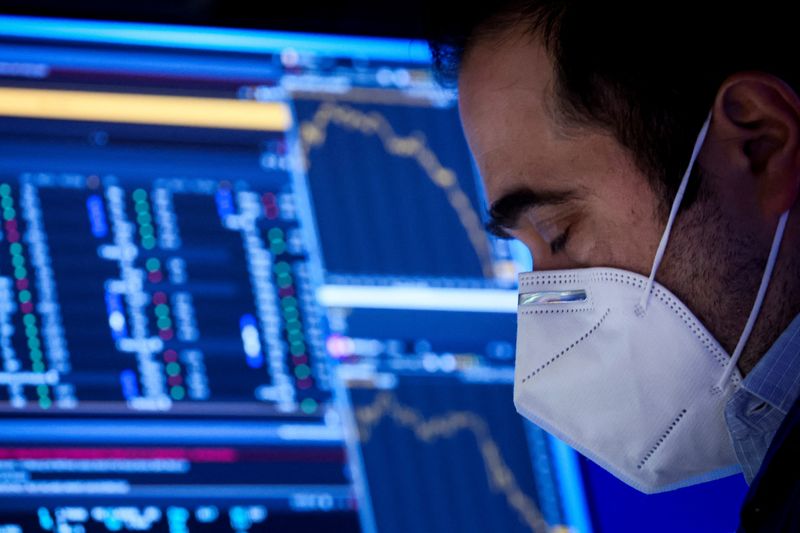By Davide Barbuscia
NEW YORK (Reuters) - Investors seeking to gauge the impact of the U.S. Federal Reserve's rate-hiking plans are keeping an eye on less closely watched corners of the U.S. Treasuries market that appear to have priced in the risk of a sharp economic slowdown.
The shape of the U.S. Treasuries yield curve reveals monetary policy and economic growth expectations, and curve inversions - which happen when shorter-dated debt yields more than government bonds with longer maturities - are seen as presaging recessions, particularly in the closely followed two-year and 10-year spread.
Analysts are pointing to inversions in lesser-followed sections of the curve: The yield premium of U.S. Treasury 10-year bonds over seven-year notes went negative in intraday trade last week for the first time since mid December, and forwards contracts saw an inversion.
"Whenever you see an inversion, it does raise concerns," said Edward Moya, senior market analyst at Oanda.
Technical factors may contribute to some of those inversions, but some investors still see them as reflecting broader concerns that the U.S. central bank may hurt the economy by hiking interest rates too aggressively to counter inflation.
"Markets are still a little bit nervous of the Fed overshooting," said John Herrmann, director of U.S. interest rates forecasts and strategy at NatWest Markets Securities.
"When I talk to clients, 90% of clients are in the camp that they're worried over the next two years to three years that the Fed does a policy mistake," he said, pointing to concerns that the Fed may have to resort to cutting rates after raising them, should its planned policy tightening damage the economic outlook.
Yields of shorter-dated U.S. government bonds have been rising at a much faster pace this year than longer paper, flattening the curve on expectations of an aggressive path of interest rate hikes.
"That sort of dynamic in the spot market is going to translate into much flatter forward curves in the forward market," said Subadra Rajappa, head of U.S. interest rate strategy at Societe Generale (OTC:SCGLY).
"So it's not something that's imminent ... but it's not something that you totally ignore either."
The yield curve steepened slightly this week after Fed officials spoke cautiously about the central bank's path after a widely expected March hike.
'RARE EVENT'
Investors typically look at inversions between two-year and 10-year notes as a classic sign that a recession may be coming in about one to two years. That part of the curve is not close to inversion, although it has been flattening sharply.
Other inversions, such as the one between three-month bills and 10-year notes, are also closely watched for their recession-presaging track record. That spread is also not close to inversion.
However, other parts of the curve have inverted.
The 7s/10s spread became negative briefly last week. The 20s/30s spread, in negative territory since late October, has widened to about -6 basis points from -3.30 bps on Dec. 31.
Those parts of the curve are influenced by supply and demand dynamics that make them less relevant for recession risk. For instance, pension and insurance companies looking to invest long-term tend to park their money in 30-year bonds more than 20-year ones, reducing the spread between those two maturities.
Additionally, in a flight-to-safety scenario such as when stocks tumble, investors would typically buy 10-year Treasuries, therefore reducing their premium over seven-year paper.
Still, "it's really hard to know how much of that is technical versus something fundamental," Rajappa said in reference to the brief inversion of the 7s/10s curve.
In the forwards market, which prices Treasuries for future deliveries, the two-year forward curve measuring the gap between two-year and 30-year Treasuries inverted on Monday, Citi analysts said in a note, calling it a "rare event".
Five-year and seven-year Treasuries yields were inverted in two- and three-year forward contracts on Monday, said Herrmann.
Credit Suisse (SIX:CSGN) said on Wednesday that a yield curve inversion this time around may not be the perfect predictor of a recession, given current economic conditions and the Fed's focus on reducing inflation.

Matthew Nest, global head of active fixed income at State Street (NYSE:STT) Global Advisors, said he was focused on the 2s/10s and 5s/30s curves, rather than the forward market. The 5s/30s curve has also been flattening this year.
"Curve inversions generally lead recession by 12-18 months so if the curve inverts in two years time, it is likely three years before recession becomes a real threat," Nest said.
